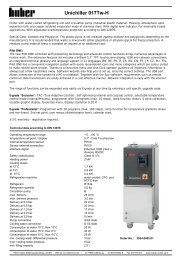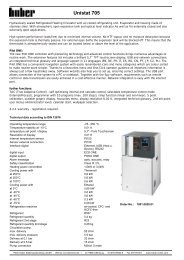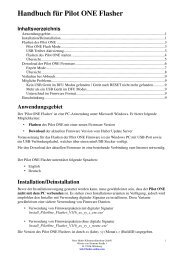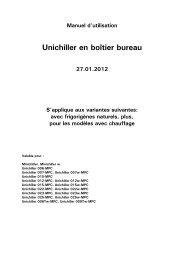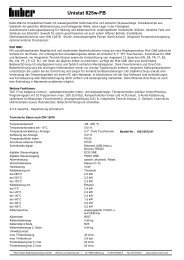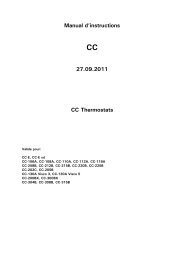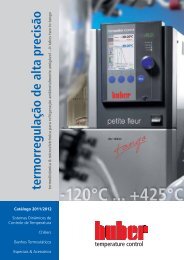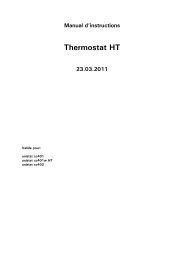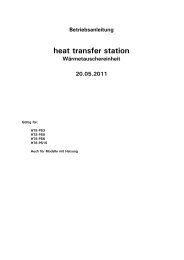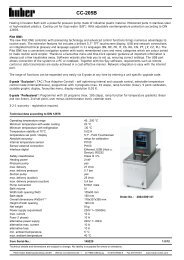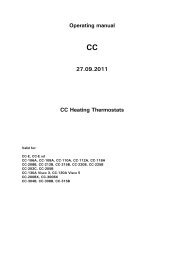Unichiller in Desktop Housing - HUBER
Unichiller in Desktop Housing - HUBER
Unichiller in Desktop Housing - HUBER
Create successful ePaper yourself
Turn your PDF publications into a flip-book with our unique Google optimized e-Paper software.
Fill<strong>in</strong>g and air purg<strong>in</strong>g an externally closed system<br />
22<br />
Caution!<br />
- For additional protection of a fragile application (e.g. glass reactor), chillers with<br />
pumps, which are able to build pressures up to 3 bar, are equipped with a VPC<br />
Bypass. Outlet pressure can be set via a valve which is next to the <strong>in</strong>let nozzles<br />
(Check the manometer display on the front of the chiller). Before operat<strong>in</strong>g the<br />
mach<strong>in</strong>e, turn the valve to the left endstop (anticlockwise). Then on start<strong>in</strong>g the<br />
pump, the smallest possible pressure will be produced.<br />
- Fill to the unit to the m<strong>in</strong>imum level necessary.<br />
- Please refer to local regulations and <strong>in</strong>ternal procedures.<br />
- When fill<strong>in</strong>g the unit, extra precautions such as earth<strong>in</strong>g the expansion vessel,<br />
fluid conta<strong>in</strong>er funnel and application may be necessary.<br />
- Personal Protection Equipment (PPE) should be worn as required by the fluid<br />
MSDS sheets, and local regulation.<br />
- Please note the temperature of the thermal fluid. The fluid should be left a room<br />
temperature for a few m<strong>in</strong>utes before dra<strong>in</strong><strong>in</strong>g.<br />
Warn<strong>in</strong>g!<br />
Overflow<strong>in</strong>g thermal fluid will create a film on surfaces, which should be cleaned up and<br />
properly disposed of as soon as possible <strong>in</strong> accordance with the MSDS <strong>in</strong>formation. If<br />
thermal fluid is spilled over the unit, the unit should be immediately turned off, and<br />
Huber-tra<strong>in</strong>ed personnel consulted.<br />
Failure to observe the above precautions may mean that the unit will not comply with<br />
all of the requirements of DIN EN 61010-2-010.<br />
Fill<strong>in</strong>g and air purg<strong>in</strong>g<br />
- Lift the bath cover / lid from the bath / <strong>in</strong>let connections<br />
- Carefully pour a suitable thermal fluid <strong>in</strong>to the expansion vessel, fill<strong>in</strong>g port (17)<br />
with help of appropriate accessories such as a funnel and / or beaker. The<br />
thermal fluid flows via the expansion vessel (18) <strong>in</strong>to the mach<strong>in</strong>e, then through<br />
the hoses <strong>in</strong>to the external application.<br />
- Then start the temperature control device and fill <strong>in</strong> thermal fluid as required.<br />
- The fill<strong>in</strong>g process / air purg<strong>in</strong>g process is f<strong>in</strong>ished when the fluid level is stable<br />
and the bath is filled sufficiently. Fill only half of the sight glass with thermal<br />
fluid. Start temperature control and fill <strong>in</strong> thermal fluid as required.<br />
- Note the volume change of the thermal fluid (especially with oils) <strong>in</strong> connection<br />
with the operat<strong>in</strong>g temperature. At the lowest temperature required, the fluid<br />
must be above the m<strong>in</strong>imum mark <strong>in</strong> the sight glass, and it must not overflow at<br />
the highest temperature required. In case of over fill<strong>in</strong>g, dra<strong>in</strong> off the excess fluid<br />
<strong>in</strong>to a suitable conta<strong>in</strong>er via the dra<strong>in</strong> (8).<br />
- With the help of the bypass on the mach<strong>in</strong>e top, set the permissible pressure<br />
that your application can carry (direction +). the pressure is displayed on the<br />
manometer.



